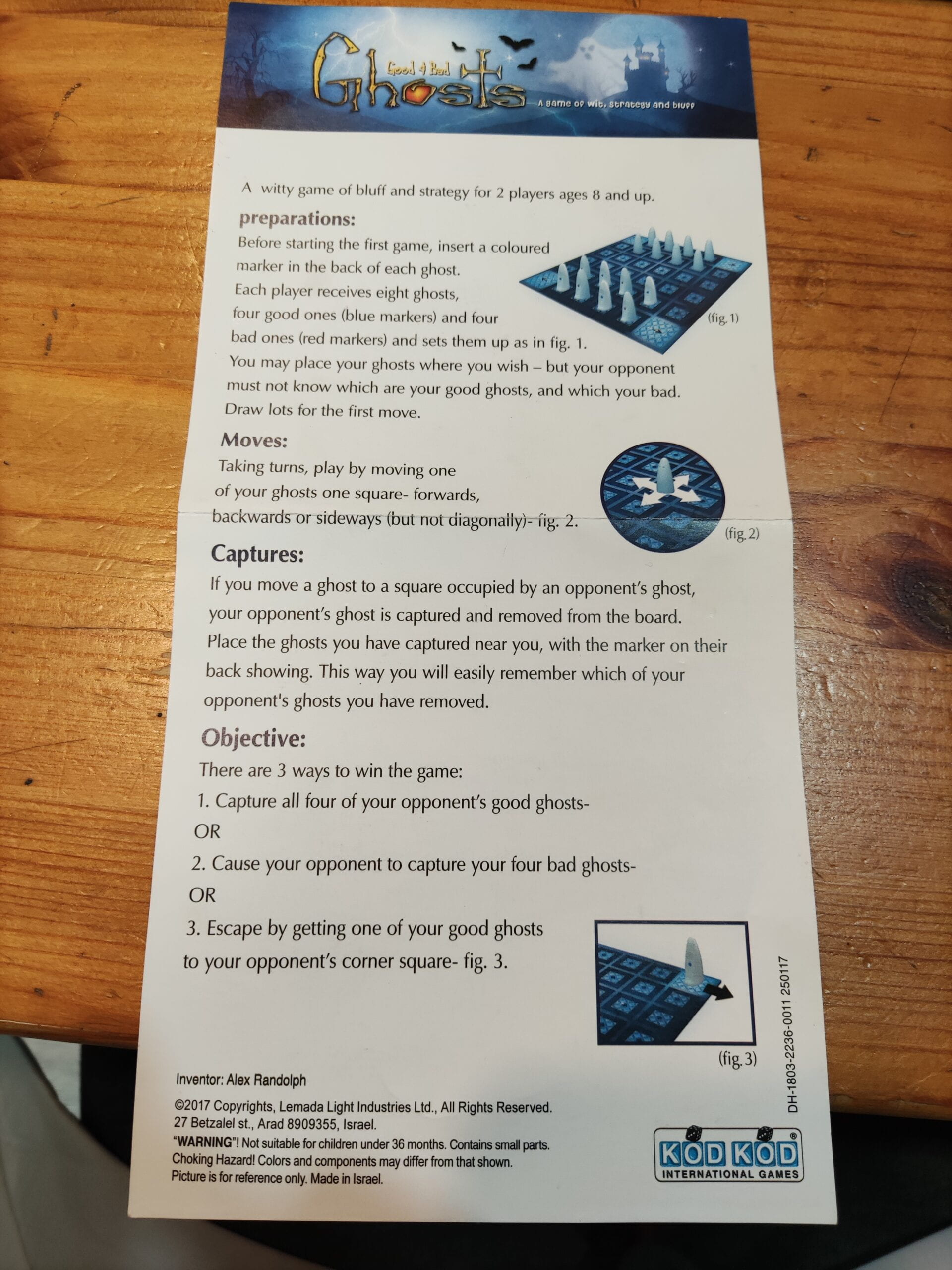On the board game field trip session, I played games including Good & Bad Ghosts, Chromino and Tofu Kingdom. Among them, my favorite is Good & Bad Ghosts, a two-player game of wit, strategy and bluff. The image below shows how it is played:

The most fun experience is derived from the mechanics that my opponent does not know whether my ghost is good or bad and the three conditions of winning the game. These mechanics make the game into a strategy game which player has to perceive whether the ghost of his opponent is good or bad depending on how the ghost moved previously and the perception of the strategy his opponent is taking. Then player need to move accordingly while hiding his own strategy and the condition of the ghost to misguide his opponent. Through the psychological war between player and his opponent and guessing whether the ghost is good or bad, player enjoys an emergent game experience as how player puts his ghosts vary at the start of the game and each time when he captures a ghost, or his ghost is captured by his opponent can change the player’s strategy.
Then, I would like to analyze how the board game Good & Bad Ghosts creates an emerging game experience for players. In chapter 3 of the book Game mechanics: advanced game design, Ernest Adams and Joris Dormans mention that “Three structural qualities of complex systems contribute to emergence: active and interconnected parts; feedback loops; and interaction at different scales.” The mechanics of Good & Bad Ghosts contains all three aspects.
Firstly, each player has 8 ghosts, 4 good and 4 bad, which provides a rich content for interconnection. Each ghost can move one square forwards, backwards or sideways and can conquer opponent’s ghosts, which offers adequate choices of action every turn. Moreover, the position for the ghosts is limited, so the move of one ghost will affect the possible action of other ghosts.
The unique objectives of the game help create both positive and negative feedback loops. For example, the winning condition “Cause your opponent to capture your four bad ghosts” and “Capture all four of your opponent’s good ghosts” encourages player to keep attacking his opponent when he captures a good ghost, while discouraging him if he captures a bad ghost.
Regarding interaction at different scales, Good & Bad Ghosts enables player to place good ghosts and bad ghosts at certain position to form a defense group or an attack group, which enlarges the scale of interaction between ghosts. Expanding further into the mental state, we can see the interaction of the two players’ strategies, perception and misguidance.
The analysis above shows that we can design an emergent experience intentionally by designing the three components. However, from my perspectives, it is more difficult to design emergent experience in video games than in board games, as board games are born with some components for emergent experience, which lies in its gameplay.
It’s often hard to find distinctions between the gameplay of video games and the one of board games, as there are tons of examples of transforming a board game into a digital version. However, I identify two things that is unique to board games, the offline environment and players’ interpretation of the gameplay.
Offline environment is quite self-explainable, which is that players usually play board games face-to-face. This offers players with a new input which is hardly used in video games, seeing their opponents. For example, when playing the board game Tofu Kingdom, player acting the prince needs to identify the identity of other players by asking questions. In this situation, recognizing facial expression of other players may be more helpful than using logic to infer the identity. This new input causes a new feedback loop, as player may be more careful about traps when he sees that his opponent is smiling.
Another difference in gameplay is that players need to interpret gameplay themselves when playing board games, while the gameplay is interpreted by computer in video games. Take Good & Bad Ghosts as an example, though it clearly mentioned the initial position of the ghosts in the rules, we didn’t see it when playing it for the first time, so we placed the ghosts randomly at the last two rows of the chessboard rather than the eight fixed blocks, which brought us a different game experience compared with the correct one. This misinterpretation unique to board games directly changes the complex system of the gameplay, which provides players with a more emergent experience.
In summary, designing active and interconnected parts, feedback loops, and interaction at different scales can help create emergent game experience in games. And the type of games can also influence the emergent game experience of players, like the offline environment and players’ interpretation of the gameplay in board games.